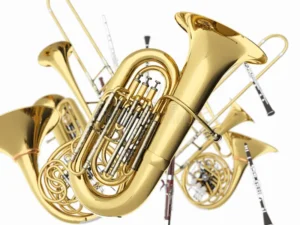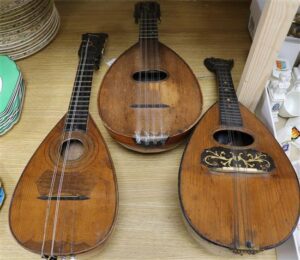Musical Instruments of India 2024
Musical Instruments 2024
Musical instrument to produce melodies are known as musical instruments.
The way they make sound divides them into four families: wind (such as the flute and trumpet) instruments, which use air flow to produce sound; percussion (such as drums and xylophones) instruments, which use striking or shaking; and keyboard (such as the piano and organ) instruments, which combine elements of both wind and string instruments.
The distinctive design and playing style of each instrument add to the vast range of tones and genres present in music throughout the world.
There are four major traditional categories of musical instruments according to the type of instrument and natya shastra involved.
Bound instrument
These are membranophonic Musical Instruments because they have an outer membrane through which they are struck to produce a particular musical sound.
They are also known as blow instruments because they are struck to produce musical sounds. They have one or two sides covered with skins or leather. Dundubhi is also the oldest land in this range. Included in this category are the musical instruments like tabla, drum, dhol, Congo, mridang, etc. While tabla is the accompaniment of most Hindustani classical vocal music, mridang, mridang, mridang, etc.

These are of the airphone category i.e. they include all air instruments, the most common Musical Instruments include flute to barber, pungi etc. The most common but difficult to play instrument in this category is the clarinet. It is an air instrument difference with a double tube with a wide tube on the head. It is one of the oldest instruments in India.
The high title of Shehnai Raja was given to the great Ustad Bismillah Khan. Through his soulful playing he took the Shehnai to its climax One of the most common instruments that can be found in every household is the flute which has been in use since the Vedic period. Initially called a Nadi or tunao, it became a revered object when the image of Lord Krishna playing the flute became a symbol of the Hindu imagination. One of the most famous flute players of India is Pandit Hariprasad Chaurasia.
Cube instrument
This is the style of no drum stroke instrument which does not require any tuning, they are also called Indio phones, popular examples from the body of Dhanwad, Manjira, Jal Taran, Glass, Tarang, Ghungroo Ghatam Kartal etc. Manjira or Chhang is a small brass chanj, it is used in temples, archaeological excavations have found Manjira to be as old as the Harappan civilization.
CardoPhon
These cards are the phone or string middle Musical Instruments. They produce the most effective music when modified by hand in the sound. There are three types of musical instruments. Arched instruments in which the sound is produced by blowing a bow across the strings.
For example, the violin, the Asar, the heart, the Ruba, and the violin. Placattrorl: Instruments in which strings are drawn with the fingers or strings or horns, for example, sitar, veena, tanpura, guitar, etc., India gave birth to many of the best artists in the field of musical instruments. The Bangus family is considered to be among the 20th century Agardoots, there are many gharanas playing the sitar, for example Jaipur, Varanasi, Etawah gharana.

Dulcimer
There are 100 stringed Musical Instruments and the traditional instrument of Jammu and Kashmir since ancient times, Sufiana Kalam is the accompaniment of santur with music.
Folk musical instruments
The stringed Musical Instruments tum is also played during pangana in this Punjab. A Tara It is a stringed Musical Instruments played by wandering sadhus Two Tara A two-stringed instrument played by Bahul. Chikara bent yantra is used in Rajasthan,
Uttar Pradesh and Madhya Pradesh, Dilruba or israj in Punjab and in eastern India is used for accompaniment by Rabindra Sangeet Onavallu is made of bamboo in Kerala. Sarida, an important tribal instrument, is played by the Santhals in the inter-eastern India. It is also used in Rajasthan and Assam. It is like the sarangi.

Musical instrument played with blow Pungi or Bin It is used by snake charmers made by dried taurai and two bamboo sticks or. Algoja consists of two flutes and is popular as a folk music instrument in the northwestern India, especially in Punjab.
Tangmuri is a folk music instrument of the people of the Khasi hill region of Meghalaya. Titti It is similar to a bagpiper and is made from goat skin. The head is an important folk music instrument of Rajasthan and Uttar Pradesh, targeted at Garhwal in Uttarakhand, and is made of bamboo and used in the Vihu festival of Assam. And it is played in the Ganesh festival in Goa.
Idakka It is like a Damrau and is used in Kerala Urdu kai It is a sand-shaped Damrau-like difference in Tamil Nadu Sambhal It is like a drum It is protected by sticks in the Konkan region of Maharashtra. This is an important two-headed musical instrument of the Dhamak Sansthan tribe played with drums trucks. The percussive musical instruments that produce the sound of the tongs evolved from the tongs used in fire and are used in Punjab Diggi is a folk dholak from. Ghadiya village in Uttar Pradesh.
The pot is made of pottery. It is used in the folk music of Punjab. Andel is used in Katha Kirtan. It is made of two circular hollow rings of metal.
Modern developments in music
The process of development of music has been endless since its inception In the twentieth twenty-first century, many attempts have been made for the rapid development of the music industry. There are institutions that teach music to students and provide them with an educational background in the subject.
Gandharva Mahavidyalaya
V.D Paluskar established this school in 1901 with the express objective of teaching and transmitting knowledge of Indian cultural music and dance to future generations. Initially opened in Lahore, it shifted to Mumbai in 1915. The college focuses on Hindustani and Carnatic classical forms of music.
Prayag Sangeet Samiti
It was established in 1926 in Allahabad to impart education in Hindustani classical music.
Sangeet Natak Academy
The Sangeet Natak Academy was the first national academy for the arts established by the Government of India in 1952. The Academy focuses on creating systems for the sustainability of musical drama in India, in that it is expected to be the primary marriage for the performing arts in the country. It is also expected to promote the vast intangible heritage of India performed through forms of music, dance and drama.
Marish Music College
It is one of the premier institutions for studying classical music in India. Aries was founded in 1920 by the great musician Vishnu Narayan Bhatkhande. He moved back to his native place Lucknow to establish this school. It focuses on the theory of music as well as the practice of singing and playing instruments. Later it was named as Bhatkhande Music Institute
Spic Macay
Kiran Seth founded the Spic Macay Community in 1977. The full name of the organization is Society for the Promotion of Indian Classical Music and Culture among the Youth. It started as a Samavaikal Youth Movement. The core of this organization is to promote Indian classical music, dance, yoga, meditation and other aspects of Indian culture as a platform for the younger generation to showcase the culture of India.It targets the common people and youth by organizing many free entry programs and gradually it has become a gigantic organization with a large number of branches all over the world.
Chatur Prahar
Yeh Hai is an annual classical music festival held at the National Centre for the Arts in Mumbai, based on the concept of Rago and time affiliation.
Conclusion
Musical instruments are indispensable instruments of human expression that cut across all cultural and temporal barriers. They stimulate creativity and emotional connection by bringing melodies, rhythms, and harmonies to life. Every Musical Instruments, whether it be a modern electric guitar or a traditional Saraswati Veena, has a distinct sound and cultural significance. The fundamental function of musical instruments has not changed over time—that is, to convey and arouse feelings—despite technological advancements and shifts in artistic expression. Around the world, people are still inspired, amused, and brought together by musical instruments, whether they are played by a single performer or an orchestra.
Comments
Post a Comment